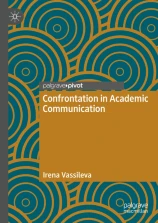Confrontation in academic communication
 This book examines the argumentation strategies employed by linguists in voicing criticism, looks for explanations for confrontation in academic discourse, and evaluates the positive and/or negative effects it has on international academic communication. Issues such as the role of intertextuality, cross-cultural variations, and the notion of “academic discourse community” are also touched upon. Special attention is paid to the modern developments in contrastive rhetoric studies, as well as to the controversial issue of the use of context-based versus corpus-based methods. The corpus under investigation consists of academic book reviews in English and German with a clearly stated negative character, as well as a series of publications in English interrelated by the fact that they discuss a common group of problems but from two fully confrontative points of view. They illustrate what has been called an “academic war”. Some related theoretical issues are also discussed, including the role of evaluation in academic communication, the relationship between criticism, critique, negative evaluation, and confrontation in academic communication, as well as the importance of culture, discipline culture, and communities of practice. The contrastive discourse analysis demonstrates differences between English and German in terms of the rhetorical strategies employed by review writers to express criticism. The book will be of interest to researchers in the fields of academic communication and rhetorics, as well as teachers in English/German for academic purposes.
This book examines the argumentation strategies employed by linguists in voicing criticism, looks for explanations for confrontation in academic discourse, and evaluates the positive and/or negative effects it has on international academic communication. Issues such as the role of intertextuality, cross-cultural variations, and the notion of “academic discourse community” are also touched upon. Special attention is paid to the modern developments in contrastive rhetoric studies, as well as to the controversial issue of the use of context-based versus corpus-based methods. The corpus under investigation consists of academic book reviews in English and German with a clearly stated negative character, as well as a series of publications in English interrelated by the fact that they discuss a common group of problems but from two fully confrontative points of view. They illustrate what has been called an “academic war”. Some related theoretical issues are also discussed, including the role of evaluation in academic communication, the relationship between criticism, critique, negative evaluation, and confrontation in academic communication, as well as the importance of culture, discipline culture, and communities of practice. The contrastive discourse analysis demonstrates differences between English and German in terms of the rhetorical strategies employed by review writers to express criticism. The book will be of interest to researchers in the fields of academic communication and rhetorics, as well as teachers in English/German for academic purposes.
zum Buch im KatalogPlus
zum Buch auf der Verlags-Website
Of emoji and semioliteracy. Reading, writing, and texting in the literacy instruction classroom
 In service to their unique demographic of learners, developmental reading and writing instructors must steadfastly teach basic literacy skills to a diverse student population with varying degrees of literacy proficiency. Even more dauntingly, educators are tasked with procuring andragogically-and-pedagogically appropriate teaching tools – those that meet the needs of the individual student while being accessible and relatable to this adult learner demographic. Of Emoji and Semioliteracy: Reading, Writing, and Texting in the Literacy Instruction Classroom proposes emoji as one such viable literacy and postsecondary writing teaching tool. Drawing from a mixed-methods study, this work chronicles a Texas community college integrated reading and writing project in which students attempt to demonstrate mastery of State-mandated literacy content areas using both traditional writing and emoji. By postulating emoji as a semioliteracy-based instructional tool, this work also explores emoji’s wider implications on teaching reading and writing within the developmental, First-Year Writing, postsecondary, and literacy instruction classes across all levels and disciplines.
In service to their unique demographic of learners, developmental reading and writing instructors must steadfastly teach basic literacy skills to a diverse student population with varying degrees of literacy proficiency. Even more dauntingly, educators are tasked with procuring andragogically-and-pedagogically appropriate teaching tools – those that meet the needs of the individual student while being accessible and relatable to this adult learner demographic. Of Emoji and Semioliteracy: Reading, Writing, and Texting in the Literacy Instruction Classroom proposes emoji as one such viable literacy and postsecondary writing teaching tool. Drawing from a mixed-methods study, this work chronicles a Texas community college integrated reading and writing project in which students attempt to demonstrate mastery of State-mandated literacy content areas using both traditional writing and emoji. By postulating emoji as a semioliteracy-based instructional tool, this work also explores emoji’s wider implications on teaching reading and writing within the developmental, First-Year Writing, postsecondary, and literacy instruction classes across all levels and disciplines.
zum Buch im KatalogPlus
zum Buch auf der Verlags-Website

In service to their unique demographic of learners, developmental reading and writing instructors must steadfastly teach basic literacy skills to a diverse student population with varying degrees of literacy proficiency. Even more dauntingly, educators are tasked with procuring andragogically-and-pedagogically appropriate teaching tools – those that meet the needs of the individual student while being accessible and relatable to this adult learner demographic. Of Emoji and Semioliteracy: Reading, Writing, and Texting in the Literacy Instruction Classroom proposes emoji as one such viable literacy and postsecondary writing teaching tool. Drawing from a mixed-methods study, this work chronicles a Texas community college integrated reading and writing project in which students attempt to demonstrate mastery of State-mandated literacy content areas using both traditional writing and emoji. By postulating emoji as a semioliteracy-based instructional tool, this work also explores emoji’s wider implications on teaching reading and writing within the developmental, First-Year Writing, postsecondary, and literacy instruction classes across all levels and disciplines.
